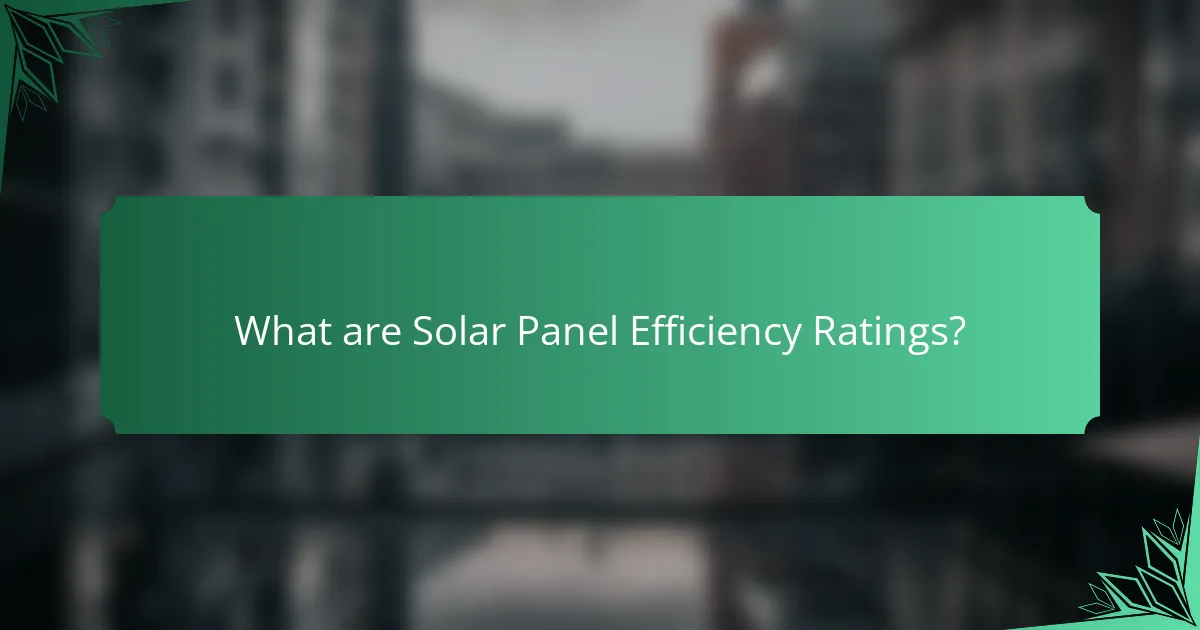
What are Solar Panel Efficiency Ratings?
Solar panel efficiency ratings measure how effectively a solar panel converts sunlight into usable electricity. These ratings are typically expressed as a percentage. Higher efficiency ratings indicate that a panel can produce more electricity from the same amount of sunlight. Most modern solar panels have efficiency ratings between 15% and 22%. Monocrystalline panels usually have higher efficiency ratings compared to polycrystalline panels. For example, the highest-rated monocrystalline panels can exceed 22% efficiency. This efficiency is crucial for maximizing energy production in limited spaces.
How are solar panel efficiency ratings determined?
Solar panel efficiency ratings are determined by measuring the amount of sunlight converted into usable electricity. This is typically expressed as a percentage. The testing process is standardized by organizations like the International Electrotechnical Commission (IEC).
During testing, solar panels are exposed to simulated sunlight conditions. The output power is measured under specific temperature and light intensity conditions. The efficiency rating is calculated by dividing the panel’s output power by the input solar power.
For example, if a panel generates 300 watts under 1000 watts of sunlight, its efficiency is 30%. Higher efficiency ratings indicate better performance and more electricity generation per square meter. This data helps consumers compare different solar panel options.
What factors influence solar panel efficiency ratings?
Solar panel efficiency ratings are influenced by several key factors. These factors include the type of solar cell technology used, such as monocrystalline or polycrystalline. Monocrystalline panels generally have higher efficiency ratings due to their single-crystal structure, which allows for better electron flow.
The quality of materials also plays a significant role. Higher purity silicon in monocrystalline panels leads to improved performance. Temperature impacts efficiency as well; solar panels typically perform better in cooler conditions.
The angle and orientation of the panels affect how much sunlight they capture. Panels positioned at optimal angles receive more sunlight, enhancing efficiency.
Lastly, shading from nearby objects can significantly reduce a panel’s efficiency. Studies show that even partial shading can lead to a drop in output. These factors collectively determine the efficiency ratings of solar panels.
Why are efficiency ratings important for consumers?
Efficiency ratings are important for consumers because they indicate how effectively a solar panel converts sunlight into electricity. Higher efficiency ratings mean that a solar panel can produce more energy in a smaller space. This is particularly beneficial for consumers with limited roof space. Additionally, efficiency ratings help consumers compare different solar panel options. They can make informed decisions based on energy output and long-term savings. For instance, a panel with a 20% efficiency rating generates more electricity than one with a 15% rating under the same conditions. Understanding these ratings allows consumers to optimize their investment in solar technology.
What are the common efficiency ratings for solar panels?
Common efficiency ratings for solar panels typically range from 15% to 22%. Monocrystalline panels generally achieve higher efficiency, often exceeding 20%. Polycrystalline panels usually fall between 15% and 18%. Some advanced panels can reach efficiencies above 22%. These ratings indicate how effectively a panel converts sunlight into electricity. Higher efficiency ratings mean more power generation in a smaller area. According to the National Renewable Energy Laboratory, advancements in technology continue to improve these efficiency ratings annually.
How do different manufacturers compare in efficiency ratings?
Different manufacturers of solar panels exhibit varying efficiency ratings. Leading manufacturers like SunPower and LG often achieve efficiencies above 22%. In contrast, brands such as Canadian Solar and Jinko typically range from 17% to 20%. These efficiency ratings are crucial as they determine the energy output of solar panels. Higher efficiency panels generate more electricity per square foot. According to the National Renewable Energy Laboratory, SunPower consistently ranks at the top for efficiency. Moreover, efficiency impacts the overall cost-effectiveness of solar installations, influencing consumer choices.
What is the significance of a higher efficiency rating?
A higher efficiency rating in solar panels indicates a greater ability to convert sunlight into usable electricity. This efficiency directly impacts the energy output of the panel. For instance, a panel with a 20% efficiency will produce more electricity than one with a 15% efficiency under the same conditions. Higher efficiency ratings allow for more power generation in limited space. This is particularly beneficial for residential installations where roof space may be constrained. Additionally, higher efficiency can lead to better performance in low-light conditions. Research shows that monocrystalline panels typically have higher efficiency ratings compared to polycrystalline panels. This makes them a preferred choice for maximizing energy production.

What is the difference between Monocrystalline and Polycrystalline solar panels?
Monocrystalline solar panels are made from a single crystal structure, while polycrystalline solar panels consist of multiple crystal structures. Monocrystalline panels typically have higher efficiency ratings, averaging around 15-20%. In contrast, polycrystalline panels usually range from 13-16% efficiency. The manufacturing process for monocrystalline panels is more energy-intensive, leading to higher costs. Polycrystalline panels, being less expensive to produce, offer a more budget-friendly option. Monocrystalline panels perform better in low-light conditions due to their uniform structure. Polycrystalline panels may have a shorter lifespan, generally around 25 years, compared to 30 years or more for monocrystalline panels. Overall, the choice between the two depends on budget, space, and efficiency needs.
How do Monocrystalline solar panels work?
Monocrystalline solar panels work by converting sunlight into electricity using silicon cells. These cells are made from a single crystal structure, which allows for higher efficiency. When sunlight hits the silicon cells, it excites electrons, creating an electric current. This process is known as the photovoltaic effect. Monocrystalline panels typically have efficiencies ranging from 15% to 22%. Their uniform black color indicates high purity in silicon. This purity contributes to better performance in low light conditions. Additionally, monocrystalline panels have a longer lifespan, often exceeding 25 years.
What are the advantages of Monocrystalline solar panels?
Monocrystalline solar panels offer high efficiency and space-saving benefits. Their efficiency can reach up to 22%, making them one of the most efficient solar panel types available. They require less space compared to other types, such as polycrystalline panels, to produce the same amount of energy. This is particularly beneficial for installations with limited roof space.
Additionally, monocrystalline panels have a longer lifespan, often exceeding 25 years, which is supported by warranties from manufacturers. They also perform better in low-light conditions, which enhances their energy production on cloudy days. The uniform black color of monocrystalline panels adds an aesthetic advantage, making them visually appealing for residential installations.
These panels are also more environmentally friendly due to their higher energy yield and reduced land use requirements. Overall, the combination of efficiency, longevity, and aesthetic appeal makes monocrystalline solar panels a preferred choice for many consumers.
What are the disadvantages of Monocrystalline solar panels?
Monocrystalline solar panels have several disadvantages. They are generally more expensive than polycrystalline panels due to higher manufacturing costs. The efficiency of monocrystalline panels can decrease in high temperatures, impacting overall performance. They also require more energy to produce, which can contribute to a larger carbon footprint during manufacturing. Additionally, if broken, they can be more difficult to recycle compared to other types of panels. Finally, their performance can be affected by shading, as even partial shading can significantly reduce energy output.
How do Polycrystalline solar panels work?
Polycrystalline solar panels work by converting sunlight into electricity through photovoltaic cells. These cells are made from silicon crystals that are melted together. When sunlight hits the cells, it excites electrons, generating an electric current. This process is known as the photovoltaic effect.
The efficiency of polycrystalline panels typically ranges from 15% to 20%. This efficiency is lower compared to monocrystalline panels, which can reach up to 22%. Despite this, polycrystalline panels are often more affordable to produce. They are characterized by a bluish hue and a speckled appearance due to the multiple silicon crystals used.
The manufacturing process involves pouring molten silicon into a mold and allowing it to crystallize. This method is less energy-intensive than the production of monocrystalline panels. Overall, polycrystalline solar panels are a viable option for renewable energy, balancing cost and efficiency effectively.
What are the advantages of Polycrystalline solar panels?
Polycrystalline solar panels offer several advantages. They are generally more affordable than monocrystalline panels. This cost-effectiveness is due to a simpler manufacturing process. Polycrystalline panels also perform well in high-temperature conditions. They have a lower temperature coefficient compared to other types. This means they lose less efficiency as temperatures rise. Additionally, polycrystalline panels are more environmentally friendly to produce. They require less energy to manufacture than monocrystalline panels. Their production generates less waste, contributing to sustainability. Overall, polycrystalline solar panels provide a balance of cost, efficiency, and environmental benefits.
What are the disadvantages of Polycrystalline solar panels?
Polycrystalline solar panels have several disadvantages. They generally have a lower efficiency compared to monocrystalline panels. This means they require more space for installation to produce the same amount of energy. Their production process is less energy-efficient, leading to higher carbon emissions during manufacturing. Polycrystalline panels also tend to perform worse in high-temperature conditions. Their performance can degrade more quickly due to shading effects. Additionally, they often have a shorter lifespan compared to monocrystalline options. These factors can impact the overall return on investment for users.

How do Monocrystalline and Polycrystalline panels compare in performance?
Monocrystalline panels generally outperform polycrystalline panels in efficiency. Monocrystalline panels typically have an efficiency rating of 15% to 22%. In contrast, polycrystalline panels usually range from 13% to 16% in efficiency. The higher efficiency of monocrystalline panels is due to their single-crystal structure, which allows for better electron flow. This structure also enables monocrystalline panels to perform better in low-light conditions. Polycrystalline panels, made from multiple crystal structures, tend to have a lower performance in shaded environments. Additionally, monocrystalline panels often occupy less space for the same energy output. This performance difference is significant when considering installation areas with limited space.
What performance metrics should be considered when comparing the two types?
When comparing monocrystalline and polycrystalline solar panels, several performance metrics should be considered. These metrics include efficiency, temperature coefficient, degradation rate, and cost per watt. Efficiency measures how much sunlight is converted into usable electricity. Monocrystalline panels typically have higher efficiency ratings, averaging around 15-22%. Polycrystalline panels usually range from 13-16% efficiency.
The temperature coefficient indicates how performance changes with temperature. A lower temperature coefficient is preferable. Monocrystalline panels generally have a better temperature coefficient, leading to better performance in high temperatures.
The degradation rate reflects how much a panel’s output decreases over time. Monocrystalline panels often have lower degradation rates, maintaining performance better over the years. Lastly, cost per watt is crucial for evaluating economic viability. While monocrystalline panels are usually more expensive, their higher efficiency may lead to better long-term savings.
How does temperature affect the performance of each type?
Temperature significantly impacts the performance of solar panels. Monocrystalline panels generally perform better in high temperatures compared to polycrystalline panels. Monocrystalline solar cells have a lower temperature coefficient, typically around -0.3% per degree Celsius. This means their efficiency decline is less pronounced as temperatures rise. In contrast, polycrystalline panels have a higher temperature coefficient, often around -0.5% per degree Celsius. This results in a greater efficiency loss in warmer conditions. Research indicates that, on average, monocrystalline panels maintain about 10% higher efficiency than polycrystalline panels at elevated temperatures. Therefore, in hot climates, monocrystalline panels are the preferred choice for optimal performance.
What is the impact of shading on performance differences?
Shading significantly reduces the performance of solar panels. When panels are shaded, their ability to convert sunlight into electricity decreases. This reduction in performance varies based on the type of solar panel. Monocrystalline panels typically perform better under partial shading compared to polycrystalline panels.
Studies show that even a small amount of shading can lead to substantial power losses. For example, research indicates that shading one cell in a string of solar cells can reduce the entire string’s output by up to 50%. This is due to the series connection of solar cells, where the performance of the entire string is limited by the weakest cell.
In contrast, bypass diodes in monocrystalline panels allow unaffected cells to continue generating power despite shading. Therefore, the impact of shading is a critical factor when comparing the performance differences between monocrystalline and polycrystalline solar panels.
What are the long-term performance expectations for each type?
Monocrystalline solar panels generally offer better long-term performance compared to polycrystalline panels. Monocrystalline panels typically have higher efficiency ratings, averaging around 15-22%. They also tend to have a longer lifespan, often exceeding 25 years. Polycrystalline panels usually have efficiencies ranging from 13-16%. Their lifespan is often slightly shorter, averaging around 20-25 years.
The temperature coefficient for monocrystalline panels is usually lower, indicating better performance in high temperatures. This means they maintain efficiency better under heat compared to polycrystalline panels. Studies indicate that monocrystalline panels can produce 10-20% more energy over their lifetime than polycrystalline counterparts.
This performance gap is crucial for long-term energy yield and return on investment.
How do degradation rates compare between Monocrystalline and Polycrystalline panels?
Monocrystalline panels generally have lower degradation rates compared to Polycrystalline panels. Monocrystalline panels typically degrade at a rate of about 0.5% per year. In contrast, Polycrystalline panels often experience degradation rates around 0.7% to 0.8% per year. This means that Monocrystalline panels maintain their efficiency longer over time. Research indicates that the more efficient manufacturing process of Monocrystalline panels contributes to their better performance longevity. Studies have shown that after 25 years, Monocrystalline panels may retain around 85% of their original efficiency, while Polycrystalline panels may retain only about 80%.
What factors contribute to the longevity of each type?
The longevity of solar panels is influenced by material quality, environmental conditions, and manufacturing processes. Monocrystalline panels typically last longer due to their high purity silicon, which enhances durability. They are also more efficient in low-light conditions, contributing to their lifespan. Polycrystalline panels, while generally less expensive, have a slightly shorter lifespan due to lower silicon purity and potential for thermal stress. Environmental factors such as temperature fluctuations, humidity, and exposure to UV radiation also affect longevity. Research indicates that high-quality monocrystalline panels can last over 25 years, while polycrystalline panels may last around 20 years.
What should consumers consider when choosing between Monocrystalline and Polycrystalline panels?
Consumers should consider efficiency, cost, space requirements, and temperature performance when choosing between Monocrystalline and Polycrystalline panels. Monocrystalline panels are generally more efficient, converting up to 22% of sunlight into electricity. Polycrystalline panels typically have lower efficiency, around 15-20%.
Cost is another factor. Monocrystalline panels are often more expensive due to their manufacturing process. Polycrystalline panels are usually cheaper, making them a budget-friendly option.
Space requirements also matter. Monocrystalline panels require less space for the same output due to their higher efficiency. This is important for consumers with limited roof space.
Temperature performance is crucial as well. Monocrystalline panels tend to perform better in high temperatures compared to Polycrystalline panels. This can affect overall energy production in warmer climates.
These factors help consumers make informed decisions based on their specific needs and circumstances.
How do cost and efficiency play a role in decision-making?
Cost and efficiency significantly influence decision-making in solar panel selection. Consumers often prioritize lower costs to maximize budget utilization. However, efficiency ratings determine the energy output relative to size. Higher efficiency panels, like monocrystalline, may have a higher upfront cost but offer better long-term savings. Research shows that monocrystalline panels can achieve efficiencies over 20%, while polycrystalline panels typically range from 15% to 18%. This efficiency can lead to reduced space requirements and lower installation costs. Therefore, decision-makers must balance initial investment against potential savings and energy production over time.
What are the installation considerations for each type?
Monocrystalline and polycrystalline solar panels have distinct installation considerations. Monocrystalline panels require more precise installation due to their rigid structure. They typically need a mounting system that accommodates their shape. Proper orientation is crucial for maximizing sunlight exposure. Additionally, these panels may require more space due to their higher efficiency.
Polycrystalline panels, on the other hand, are generally easier to install. Their construction allows for more flexibility in mounting options. These panels can be installed in various orientations without significant efficiency loss. However, they require more space compared to monocrystalline panels due to lower efficiency. This aspect should be considered when planning the installation area.
What are the best practices for maximizing solar panel performance?
To maximize solar panel performance, ensure proper installation and positioning. Solar panels should be installed at an optimal angle and orientation to receive maximum sunlight. Regular cleaning of the panels is essential to remove dirt and debris that can block sunlight. Monitoring the system’s performance helps identify any issues early. Additionally, using high-quality inverters can improve energy conversion efficiency. Regular maintenance checks can enhance longevity and performance. Studies show that well-maintained solar panels can produce up to 25% more energy than neglected ones.
Solar panel efficiency ratings are crucial metrics that indicate how effectively solar panels convert sunlight into usable electricity, typically expressed as a percentage. This article compares monocrystalline and polycrystalline solar panels, highlighting their efficiency ratings, performance differences, and factors that influence their effectiveness. Key topics include the determination of efficiency ratings, the advantages and disadvantages of each panel type, their long-term performance expectations, and considerations for consumers when selecting between the two. The discussion provides a comprehensive understanding of how these factors impact energy production and investment in solar technology.